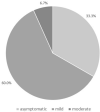Comparison of clinical severity and epidemiological spectrum between coronavirus disease 2019 and influenza in children
- PMID: 33707568
- PMCID: PMC7952543
- DOI: 10.1038/s41598-021-85340-0
Comparison of clinical severity and epidemiological spectrum between coronavirus disease 2019 and influenza in children
Abstract
Data on the novel coronavirus disease 2019 (COVID-19) in children are limited, and studies from Europe are scarce. We analyzed the clinical severity and epidemiologic aspects of COVID-19 in consecutive children aged 0-18 years, referred with a suspicion of COVID-19 between February 1, and April 15, 2020. RT-PCR on a nasopharyngeal swab was used to confirm COVID-19. 319 children met the criteria of a suspected case. COVID-19 was diagnosed in 15/319 (4.7%) patients (8 male; mean age 10.5 years). All of them had household contact with an infected relative. Five (33.3%) patients were asymptomatic. In 9/15 (60.0%) children, the course of the disease was mild, and in 1/15 (6.7%), it was moderate, with the following symptoms: fever (46.7%), cough (40%), diarrhea (20%), vomiting (13.3%), rhinitis (6.7%), and shortness of breath (6.7%). In the COVID-19-negative patients, other infections were confirmed, including influenza in 32/319 (10%). The clinical course of COVID-19 and influenza differed significantly based on the clinical presentation. In conclusion, the clinical course of COVID-19 in children is usually mild or asymptomatic. In children suspected of having COVID-19, other infections should not be overlooked. The main risk factor for COVID-19 in children is household contact with an infected relative.
Conflict of interest statement
The authors declare no competing interests.
Figures
Similar articles
-
Comparison of Clinical Features of COVID-19 vs Seasonal Influenza A and B in US Children.JAMA Netw Open. 2020 Sep 1;3(9):e2020495. doi: 10.1001/jamanetworkopen.2020.20495. JAMA Netw Open. 2020. PMID: 32897374 Free PMC article.
-
Paediatric COVID-19: Milder Presentation-A Silver Lining in Dark Cloud.J Trop Pediatr. 2021 Jan 29;67(1):fmaa106. doi: 10.1093/tropej/fmaa106. J Trop Pediatr. 2021. PMID: 33280024 Free PMC article.
-
Clinical and epidemiological characteristics of children with SARS-CoV-2 infection: a case series in Sinaloa.Bol Med Hosp Infant Mex. 2021;78(1):18-23. doi: 10.24875/BMHIM.200002021. Bol Med Hosp Infant Mex. 2021. PMID: 33661874 English.
-
Influenza and COVID-19 coinfection: Report of six cases and review of the literature.J Med Virol. 2020 Nov;92(11):2657-2665. doi: 10.1002/jmv.26125. Epub 2020 Jun 29. J Med Virol. 2020. PMID: 32497283 Review.
-
[Children and COVID-19].Arch Mal Coeur Vaiss Pratique. 2020 Oct;2020(291):11-15. doi: 10.1016/j.amcp.2020.07.005. Epub 2020 Jul 17. Arch Mal Coeur Vaiss Pratique. 2020. PMID: 32837200 Free PMC article. Review. French. No abstract available.
Cited by
-
Comparison of laboratory parameters, clinical symptoms and clinical outcomes of COVID-19 and influenza in pediatric patients: A systematic review and meta-analysis.World J Clin Cases. 2022 Oct 16;10(29):10516-10528. doi: 10.12998/wjcc.v10.i29.10516. World J Clin Cases. 2022. PMID: 36312478 Free PMC article.
-
Risk Factors of Influenza-Associated Respiratory Illnesses Reported to a Sentinel Hospital of Lahore, Pakistan: 2015-2016.Can J Infect Dis Med Microbiol. 2021 Oct 27;2021:2460553. doi: 10.1155/2021/2460553. eCollection 2021. Can J Infect Dis Med Microbiol. 2021. PMID: 34745395 Free PMC article.
-
Clinical and Epidemiological Characteristics of 1283 Pediatric Patients with Coronavirus Disease 2019 during the First and Second Waves of the Pandemic-Results of the Pediatric Part of a Multicenter Polish Register SARSTer.J Clin Med. 2021 Oct 30;10(21):5098. doi: 10.3390/jcm10215098. J Clin Med. 2021. PMID: 34768620 Free PMC article.
-
Signs and symptoms to determine if a patient presenting in primary care or hospital outpatient settings has COVID-19.Cochrane Database Syst Rev. 2022 May 20;5(5):CD013665. doi: 10.1002/14651858.CD013665.pub3. Cochrane Database Syst Rev. 2022. PMID: 35593186 Free PMC article.
-
Genomic and serological assessment of asymptomatic severe acute respiratory syndrome coronavirus 2 (SARS-CoV-2) infections in child labor.Pathog Glob Health. 2022 Oct;116(7):455-461. doi: 10.1080/20477724.2022.2038052. Epub 2022 Feb 13. Pathog Glob Health. 2022. PMID: 35152854 Free PMC article.
References
-
- World Health Organization. Coronavirus disease 2019 (COVID-19). Situation report-51. Geneva (Switzerland), World Health Organization. 2020; [cited 2020 Mar 12]. https://www.who.int/docs/default-source/coronaviruse/situation-reports/2....
Publication types
MeSH terms
LinkOut - more resources
Full Text Sources
Other Literature Sources
Medical
Miscellaneous



